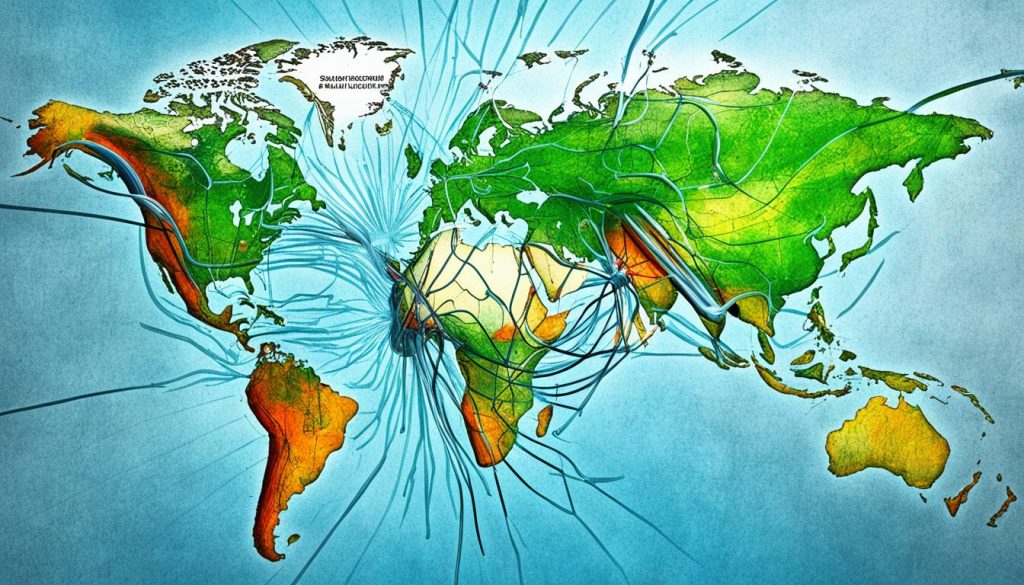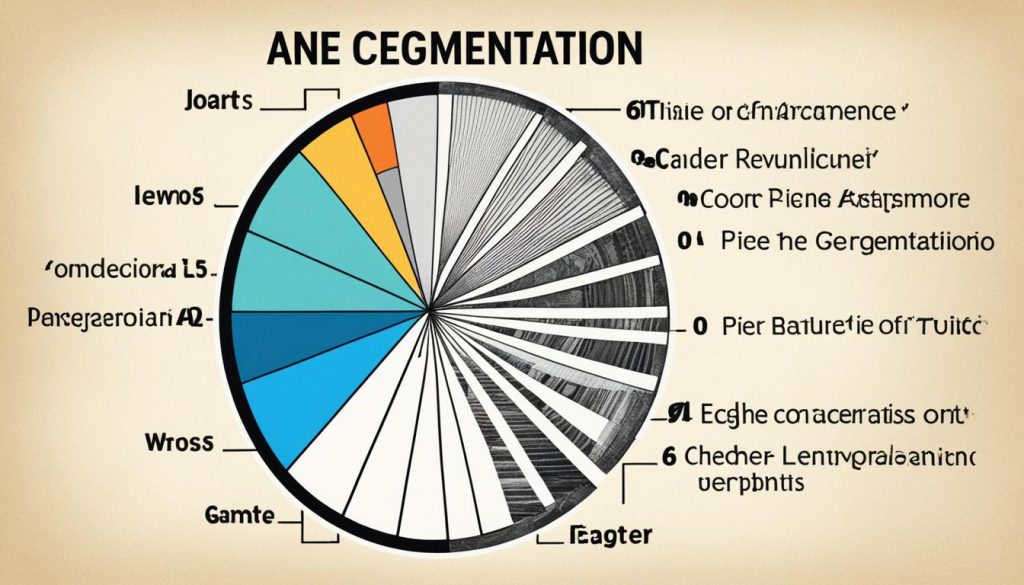Sport has truly become a key part of global entertainment. It leads to a sports business boom. Sports marketing initiatives create unforgettable moments. They connect fans to teams and expand their global reach.
Live broadcasts via the internet let events be seen worldwide. This shows how crucial digital marketers are. They promote sponsors and boost organisation income.
Óscar Mayo, LaLiga’s Executive Director, discusses the intense consumption of sports today. He underlines the importance of digital-first content marketing strategies for players, clubs, and leagues. Such strategies aim to engage today’s fans and draw a wider international audience.
Nike’s “Just Do It” and P&G’s “Thank You, Mom” show how effective sports marketing can be. They increase brand loyalty and revenue. Personal stories and athlete endorsements also play a vital role. They ensure a broad global market presence and high international consumer engagement.
Key Takeaways
- Sport is a growing part of global entertainment, driving a businesses boom.
- Digital marketers are crucial for promoting sponsors and increasing revenues.
- Live broadcasts and internet technologies make sports events accessible globally.
- Inspiring digital-first content strategies are essential for engaging modern fans.
- Iconic campaigns and athlete endorsements build brand loyalty and global reach.
Understanding Global Marketing Strategies
Businesses aiming for global markets must grasp global marketing strategies. They promote and sell worldwide, keeping a uniform brand. The iconic Nike swoosh is an example. This strengthens their international presence.
A strong sports global marketing blueprint understands cultural, economic, and regulatory aspects. It balances global standardisation with local market specifics.
Defining Global Marketing
Global marketing designs a uniform strategy for worldwide consumers. It differs from international marketing, which adapts to local needs. Netflix, for instance, customises content for each region. This boosts its global allure. It shows the value of knowing different consumer cultures for market success.
Importance of a Global Marketing Strategy
A good international market strategy is key for global growth. It ensures brand uniformity while respecting local differences. This strategy guides global marketing to keep the brand unified worldwide.
- Maintaining a consistent brand image everywhere
- Adapting to different markets’ cultural and regulatory environments
- Standardising marketing but also catering to local tastes
Using these strategies, brands overcome market diversity. They make their message universal yet respect local traditions. This mix of global and local strategies aids in market entry and builds brand loyalty worldwide.
Cultural Nuances and Localisation
Getting cultural nuances right is key for global success. Brands must mix cultural adaptation in marketing with their global brand message. This helps them connect with various audiences while staying true to their identity.
Adapting to Local Preferences
Adapting to what locals want is vital for going global. Brands might change how their products look, feel, and taste to suit local needs. Take Coca-Cola, which tweaks its designs and flavours for different countries. This makes sure their marketing hits the mark culturally.
Maintaining Brand Consistency
It’s important to stay true to your brand while adapting. Consistent branding builds recognition and loyalty everywhere. For instance, McDonald’s keeps its iconic golden arches and flavours. Yet, it adjusts its menu to appeal to local tastes.
Finding the right mix of cultural adaptation in marketing and keeping your brand’s heart is key. It helps forge a strong, unified global stance.
Effective Gamification Techniques in Marketing
Gamification has changed how brands interact with customers. It brings fun into marketing, helping to catch customer interest and keep it. By using game elements, companies can make experiences that are not just fun but also help build strong relationships with customers.
Engaging Customer Attention
Using gamification in marketing is a smart move. Brands like McDonald’s and Starbucks make their products more appealing this way. They use games and challenges on mobile apps. This taps into people’s love for achievements, like earning points or badges, making marketing fun and engaging.
Incorporating Reward Systems
Loyalty rewards are key to keeping customers coming back. Companies like Under Armour reward customers in their fitness apps. They give badges and rewards for finishing challenges. This encourages users to be active and stay loyal to the brand.
KFC Japan’s ‘Shrimp Attack’ game shows how gamification can boost sales. It made the product more known and increased sales through a fun and rewarding experience for users.
Gamification not only makes customers happy by making things interactive but also gives brands important data. This helps brands make future marketing more personal. It’s a strategy where everyone benefits: customers enjoy themselves, and brands see more loyalty and interaction.
Using Market Research to Identify Target Audience
Understanding your target audience starts with thorough market research. Looking at global market trends and analysing competitors are key. By segmenting the audience, businesses focus their efforts where it matters most. They adjust their strategies for each region.
One great example is the “This Girl Can” campaign by Sport England. It used research to boost community involvement and send a strong message.
Global Market Trends
It’s important to keep up with global market trends. This helps brands remain ahead and responsive. Looking into demographics, seeing how consumers act, and checking on local brand success gives valuable insights.
These insights help in making strategies that reach different types of consumers. This makes sure campaigns include everyone and work well.
Competitive Analysis
Doing a competitive analysis shows where you and others stand. It tells you what you’re doing well, and where you can improve. Looking closely at competitors teaches valuable lessons.
It helps in thinking up new ideas and in making products that stand out. With careful analysis, brands can meet consumer needs better than their competition.
How a Global Player Can Attract Customers
To draw in customers worldwide, one must grasp the many elements affecting buying actions across various cultures and areas. By using global customer acquisition strategies, it’s vital to dive into market research. This helps identify what locals want and need. Doing so lets global brands create plans that not only reach wider audiences but also meet specific regional tastes.
Ads featuring local heroes or unforgettable sports events often catch the eye across different countries. Take, for example, Pelé’s moment with Puma, where he tied his shoes during a game. It’s a classic in sports marketing history. These methods do wonders in attracting overseas markets and building lasting connections with the brand.
Moreover, by putting global customer acquisition strategies into action, they help broaden the international customer circle. Understanding the global love for sports and entertainment lets brands craft campaigns that cross cultural lines. This way, they pull in varied customers from all over the globe.
Crafting a Market Entry Strategy
Building a strong market entry strategy is crucial for success abroad. It’s about carefully choosing how to enter new markets. This means looking at different ways to expand and doing it step by step. This approach minimizes risks and helps businesses grow efficiently.
Evaluating Market Entry Modes
It’s essential to pick the best way to enter a market. Here are a few common methods:
- Exporting: A safe choice, exporting lets you sell products in new countries with less risk. You don’t have to spend a lot on this method.
- Licensing: Allowing others to make or sell your product can help you grow. It requires little money upfront.
- Joint Ventures: Partnering with local businesses offers insights and helps with local rules and culture.
- Wholly-Owned Subsidiaries: This more expensive option allows full control. It ensures your brand stays consistent.
Phased Approach to Market Entry
Starting slow and planning your move into new markets is wise. Begin with low-risk strategies and up your investment as you learn more. This way, you can:
- Understand the local market through research.
- Try smaller steps like exporting or licensing to feel out the new market.
- Expand more by partnering with local businesses, using their expertise.
- Go all in with wholly-owned subsidiaries when you’re sure it’s the right move.
To pick the right entry method, plan well and budget smartly. Know the market you’re entering. With good research and a step-by-step strategy, your business can thrive in new places.
Successful Sports Marketing Campaign Examples
Successful sports marketing can change how people see a brand and make them more involved. These victories often mix solid branding, creative ideas, and smart use of famous athletes. This blend helps the brand stand out and connect with people.
Nike’s “Just Do It” Campaign
Nike’s “Just Do It” campaign is unforgettable for its strong message. It encourages people to keep going, no matter what. Started in 1988, it showed sports can bring us together. Nike featured athletes from all walks of life, telling their unique stories.
This approach helped Nike become more than a sportswear brand. It turned into a sign of athletic dedication and excellence. The slogan is now part of sports culture. It also made Nike much more popular and increased its sales around the world.
Star-Driven Endorsements
Using famous athletes in ads can make a big difference. For example, when Puma worked with Pelé in the 1970 World Cup, it was a hit. Pelé wearing Puma shoes caught everyone’s attention. Under Armour’s campaign with stars like Michael Phelps did something similar.
They shared stories that touched people’s hearts. These stories, along with the athletes’ fame, created a strong bond with the audience. Picking the right athletes is key to reaching out to people and leaving a mark.
The Role of Digital Streaming in Global Marketing
Digital streaming is changing global marketing, especially in sports. Services like streaming services and digital content distribution allow fans to watch events live, worldwide. This builds a stronger bond between fans and sports.
OTT services, Facebook Live, and YouTube Live let sports marketing reach further. Live broadcasts can attract more viewers, increase engagement, and enhance sponsor value. Nowadays, adding live sports marketing to digital strategies is crucial.
Importance of Live Broadcasts
Live broadcasts bring an immediacy and closeness not found in recorded shows. By including streaming in marketing, fans globally can enjoy the action in real-time. This benefits sponsors through more visibility and engaged audiences.
Óscar Mayo, from LaLiga, notes we’re seeing more sports consumption than ever. Live streaming meets fans’ strong desires, keeping them involved and connected.
Adopting digital methods is key. It’s not just about staying current. It’s using tech to grow a worldwide fanbase and extend marketing reach like never before.
Leveraging Social Media for Global Reach
Today, using social media is key to reach people all over the world. Brands can use digital channels to meet a wide customer base. Facebook, Instagram, and Twitter help businesses make global campaigns.
Smart use of social media can up your online presence. It helps with promotions and reaching new markets. Look at #thisgirlcan by Sport England. It showed how hashtags bring people together, increase interaction, and challenge stereotypes. It connected with millions worldwide.
To make the most of digital marketing, your content must speak to many cultures. Keep your brand’s core message but make your posts relatable and interactive. This approach will make sure your campaigns touch people from different backgrounds. It allows you to connect with a global audience effectively.
Balancing Localisation and Standardisation
Finding the perfect global marketing balance is key for brands that want to connect with many markets. They need to keep their core identity while appealing to local tastes. With localisation, brands adjust their messages to fit the cultural context of each region. This approach means changing products and promotions to suit local likes and legal rules.
But, having a strong global brand doesn’t mean everything has to be the same everywhere. It’s vital for brands to find a middle ground. They should keep a core message that doesn’t change, yet add local touches. This mix helps them reach people all over the world in a meaningful way.
This approach of mixing global and local elements allows brands to stay true to themselves while being locally relevant. It creates a powerful global marketing effort. This balance makes sure the brand’s message is both universal and adaptable, reaching wide yet fitting in locally.
Adapting the 4 Ps of Marketing for Global Success
When going global, companies must tweak their *international marketing mix* to fit varied consumer tastes and laws. It’s vital to grasp the 4 Ps – Product, Price, Place, and Promotion. Modifying them is key for success in global markets.
Product Adaptation
Adjusting products to meet local needs is crucial. This can mean adding custom features, changing packaging, or making new varieties. For example, Tesco sells exotic foods aimed at diverse immigrant communities. This strategy helps make their offerings appealing to locals.
Pricing Strategy
Adjusting prices for new markets is essential. Economic conditions and buying power differ across regions. A smart pricing plan takes into account these local factors. It also considers what people are willing to pay. Apple, for instance, varies its prices by region to boost sales and profits.
Effective Distribution Channels
Getting products to the right people efficiently is about using good distribution channels. This includes local networks, online platforms, and dependable logistics partners. Unilever, for example, manages its distribution smartly across different continents. This ensures its products are always available when needed.
Culturally Relevant Promotions
Promotions should speak to local audiences and respect their culture. Ads that consider cultural differences attract more attention. Like Coca-Cola’s Share a Coke campaign that used names in various languages. It connected with people worldwide.
By adopting these regional adaptation strategies within the 4 Ps, companies can make their international marketing mix work anywhere. This approach helps in achieving global success.
Creating Engaging Content for Digital Audiences
In today’s world, catching the eye of an audience is key to a brand’s success. Good digital content can truly make a difference. It helps to reach and engage more people.
Video Content
Video marketing plays a big role in connecting with people’s emotions. For example, P&G’s “Thank You, Mum” campaign told a story that touched hearts. It increased views and interactions on social media.
Videos are great for sharing brand messages in a clear and memorable way.
Interactive Quizzes
Quizzes are a fun way to get people involved. They challenge users and reward their knowledge. Like how Under Armour’s Steph IQ gave NBA fans prizes,
it boosted involvement and helped people remember the brand. Quizzes are entertaining and improve user interaction. They help create stronger connections and more exposure for the brand.
Partnerships and Sponsorships Across Borders
Partnerships and sponsorships help brands grow and become known worldwide. Working with strategic partners and famous athletes helps companies reach more people. This builds strong connections with different groups everywhere.
Successful Brand Collaborations
Strong brand collaborations bring many advantages, like reaching new customers and making them more loyal. For instance, the Seattle Seahawks and Starbucks partnership is very successful. It uses local support to make a lasting brand image.
This kind of partnership lets companies use each other’s resources and customers. This helps them grow and become more popular across the globe.
Leveraging Athlete Endorsements
Working with athletes can make a brand more visible. It also creates a personal bond with shoppers. For example, campaigns like the Chicago Blackhawks’ #WhatsYourGoal connect deeply with fans. This increases interest and encourages online interaction.
Partnerships with athletes make a brand seem more trustworthy. They also attract loyal fans, reaching a larger and more eager market. By working across borders, brands can become popular worldwide. This leads to loyal customers over the long term.
Harnessing the Power of Storytelling in Marketing
Storytelling in marketing is now key to touching hearts. Brands craft engaging stories to form a bond with people. P&G’s “Thank You, Mom” campaign is one such story. It celebrated mothers of athletes, showing their sacrifices and support. This story touched many, making the brand’s message stronger worldwide.
The ‘Mauka Mauka’ campaign tapped into the India-Pakistan cricket excitement. It turned this rivalry into a fun story that cricket fans loved. This approach changed a regular message into something unforgettable. It sparked emotions and loyalty among customers.
Consider Reebok’s ‘Subway Pump Battle’ in Korea, where a common issue became an engaging campaign. Commuters raced in Reebok sneakers to catch subways faster. This clever use of storytelling highlighted the product’s perks. It made the brand stand out and drew people in.














